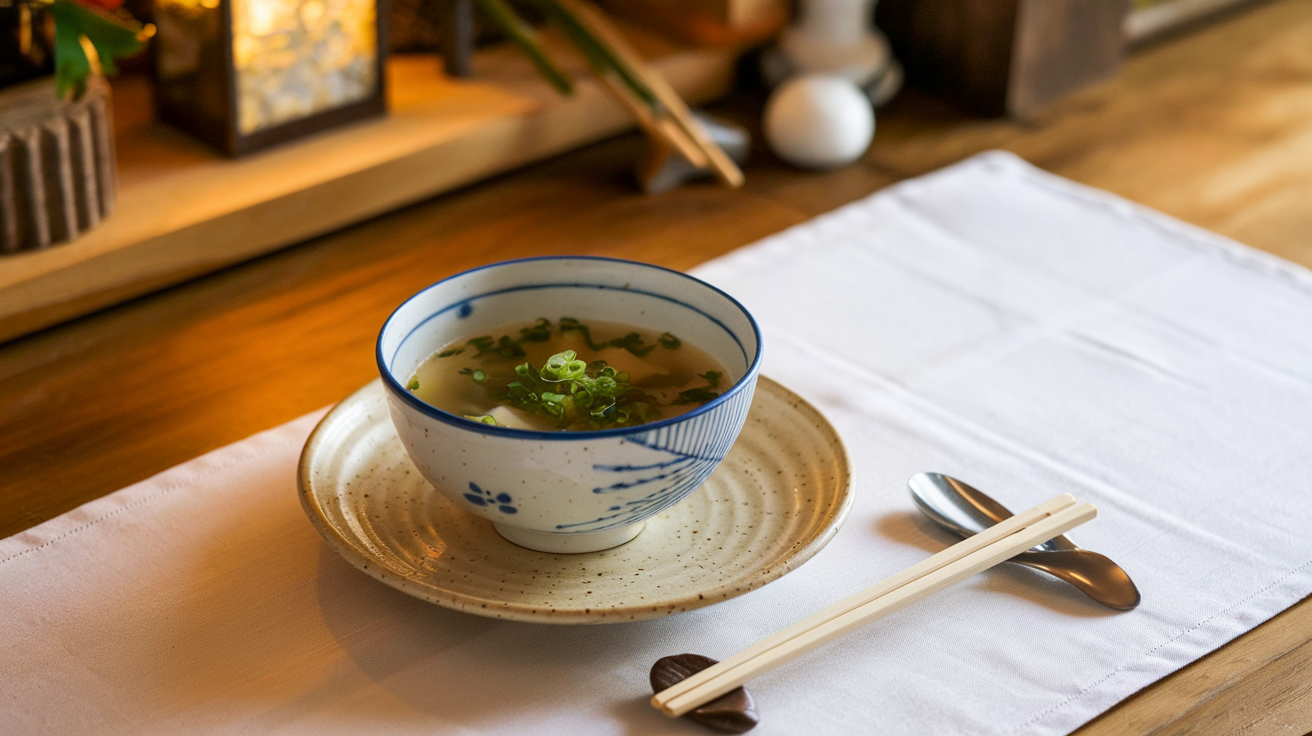Miso soup isn’t just a dish; it’s an experience. Whether you’ve enjoyed it at your favorite Japanese restaurant or you’re exploring it for the first time, this humble yet deeply flavorful soup carries a world of tradition in every bowl. Today, you’re about to learn how to create an authentic miso soup recipe that’s both simple to prepare and packed with health benefits. Let’s dive into the world of miso soup and discover what makes it a timeless favorite.
Table of Contents
What is Miso Soup?
Miso soup, or misoshiru, is a staple of Japanese cuisine and culture. Served as a starter or alongside main meals, this soup combines the umami-rich flavors of miso paste with dashi stock and other ingredients like tofu, seaweed, and green onions. It’s comforting, light, and incredibly nourishing.
A Taste of Tradition
This dish dates back to ancient Japan, where it was a dietary mainstay for samurai and villagers alike. Today, it’s enjoyed worldwide for its simplicity, adaptability, and depth of flavor.
Why It’s Loved Globally
- Simplicity with Impact: Miso soup has a short ingredient list but delivers complex flavors.
- Adaptable to Your Needs: Add-ins like vegetables, seafood, or mushrooms make it endlessly customizable.
- Healthy and Satisfying: Beyond its taste, miso soup is a nutritional powerhouse (more on that later).
Ingredients for Authentic Miso Soup
The secret to perfect miso soup lies in using fresh, high-quality ingredients. Here’s what you’ll need:
Essential Ingredients
| Ingredient | Quantity | Notes |
| Miso paste | 3 tbsp | Choose white, red, or mixed miso. |
| Dashi stock | 4 cups | Homemade or instant. |
| Tofu | 1/2 cup | Firm or silken, cubed. |
| Wakame seaweed | 2 tbsp | Rehydrated if dried. |
| Green onions | 2 stalks | Thinly sliced for garnish. |
Optional Add-Ins
- Mushrooms (e.g., shiitake or enoki).
- Fresh spinach or julienned carrots.
- Protein options like shrimp or clams.

Each ingredient brings its own texture and flavor to the soup, making every spoonful unique.
Step-by-Step Miso Soup Recipe
Creating miso soup at home is easier than you might think. Follow these steps for a bowl that tastes like it came straight from Japan.
Step 1: Prepare the Dashi Stock
Dashi is the backbone of your soup’s flavor. You can make it from scratch using kombu (dried kelp) and bonito flakes or use instant dashi granules for convenience.
- For homemade dashi: Simmer a piece of kombu in water until it almost boils. Remove the kombu, add bonito flakes, and steep for a few minutes before straining.
- For instant dashi: Dissolve granules in hot water according to package instructions.
Step 2: Add Tofu and Wakame
Bring your dashi stock to a gentle simmer. Add the cubed tofu and rehydrated wakame. These will soak up the flavors while maintaining their textures.
Step 3: Incorporate the Miso Paste
Miso paste is delicate and shouldn’t be boiled. Instead:
- Place a ladleful of hot stock in a small bowl.
- Dissolve the miso paste in the stock, stirring until smooth.
- Return the mixture to the pot, stirring gently.
Step 4: Garnish and Serve
Top with sliced green onions and serve immediately. Miso soup is best enjoyed fresh, while its flavors are vibrant and warm.
Tips for Perfect Miso Soup
Even a simple dish like miso soup can benefit from a few insider tips:
- Quality Counts: Use high-quality miso paste and dashi for authentic flavor.
- Don’t Overheat Miso: Boiling the paste diminishes its flavor and probiotic benefits.
- Customize Your Ingredients: Experiment with different vegetables, proteins, or seaweed varieties.
Health Benefits of Miso Soup
Beyond its comforting taste, miso soup offers an impressive range of health benefits:
Nutritional Highlights
- Probiotics: Fermented miso supports gut health and digestion.
- Low in Calories: A bowl of miso soup is satisfying without being heavy.
- Rich in Nutrients: Dashi provides minerals like iodine, while tofu adds protein and calcium.
Dietary Adaptability
Miso soup can be easily adapted to fit your dietary needs:
- Use kombu dashi to make it vegan.
- Select gluten-free miso paste if needed.
Common Mistakes to Avoid
Even seasoned cooks can slip up when making miso soup. Here are a few common pitfalls:
- Skipping the Dashi: Water won’t give you the same depth of flavor.
- Adding Miso Too Early: Heat destroys its delicate taste and nutrients.
- Overloading Ingredients: Keep it simple to let the miso shine.
FAQ Section
Can I Make Miso Soup Ahead of Time?
You can prepare the dashi stock and chop your ingredients in advance. However, add the miso paste only when you’re ready to serve for the best flavor.
What Type of Miso Paste Should I Use?
- White miso (shiro miso) boasts a delicate flavor with a subtle touch of sweetness..
- Red miso (aka miso) is richer and saltier.
- Mixed miso (awase miso) offers a balanced flavor.
Is Miso Soup Good for Weight Loss?
Absolutely! It’s low in calories, filling, and packed with nutrients, making it an excellent choice for a light meal or starter.
Can I Freeze Miso Soup?
While you can freeze the dashi base, it’s best to add fresh miso paste and toppings when reheating.
Embrace the Tradition: Try Miso Soup Today
There’s something magical about creating a traditional dish in your own kitchen. Miso soup is a reminder that simplicity can be deeply satisfying. Whether you’re savoring it as a comforting starter or enjoying it as a light meal, this recipe will bring the warmth and authenticity of Japan to your table.
So, why wait? Gather your ingredients, follow these steps, and let your culinary journey begin. Don’t forget to share your experience and any creative twists you’ve added in the comments below. Your perfect bowl of miso soup is just a ladle away!

